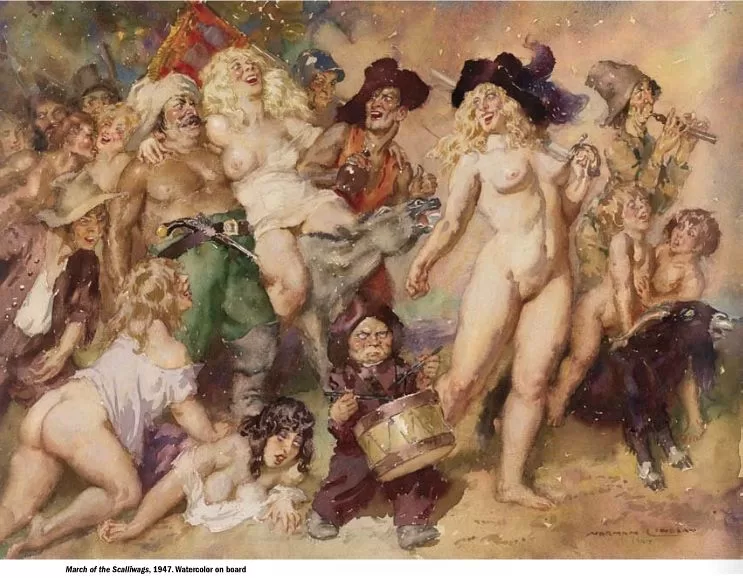Part Two of Norman Lindsay’s adventures in the USA examines his success in the art world especially with discerning art collectors … Part One is here: Australian artist Norman Lindsay in America
Norman Linday’s solution to the challenge of seeing worthy Australian prose and poetry into print was to establish the Endeavour Press that, although it only survived about two and a half years, successfully published about twenty titles.
Lindsay’s work surfaces again here in Esquire, The Magazine for Men, in the August 1936 issue. Under the title that Norman himself suggested (in a letter to Ben Abramson dated December 23, 1931), “Our Other Faces,” five beautiful pen and inks from the collection of The Argus Bookshop are presented on a single full page.
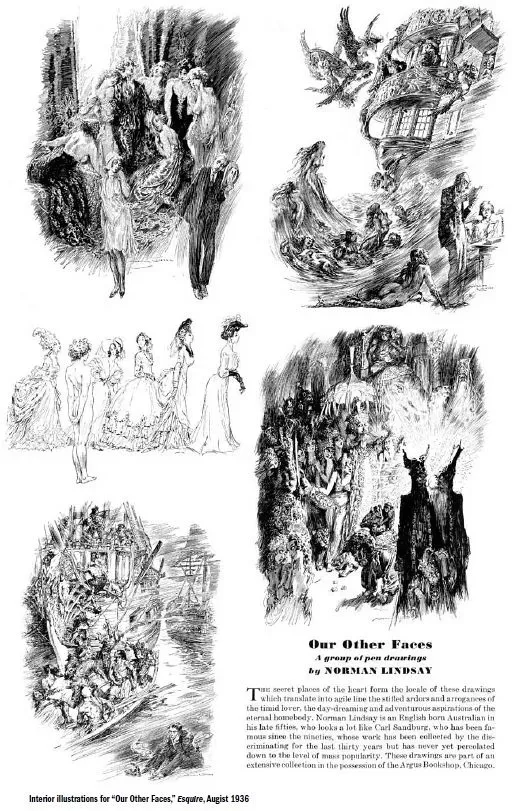

Norman Lindsay, Our Other Faces, Esquire, 1936
These were first commissioned by Abramson when Lindsay was in New York in 1931. They are almost the polar opposite of the work of the other featured artist in this issue, Ivan Albright, where we are given four examples of his portraits, with their grossly coloured and textured skin.
Lindsay’s drawings depict scenes such as a seated frustrated looking man fantasizing about a buccaneer’s life, in another a late middle-aged man stands before his wife reading a book that conjures up a fantastic scene of beautiful mermaids and harpies flinging themselves towards the stern of a galleon.
Perhaps the most important news magazine in America from its inception until now, Time, The Weekly Newsmagazine, in the July 11, 1938 issue, there appeared a review of Norman’s book Age of Consent.
The unknown reviewer, after a brief plot summary of this novel whose central character Mudgett is an artist much like Lindsay himself, concludes that:
“By the time his emotions are most involved he is painting like a genius, thus demonstrating Author Lindsay’s sly thesis that artists’ search for solitude is futile, that they create best, not when they have things their own way, but when the world is too much for them.”
Unknown reviewer of Norman Lindsay’s art
The truly flattering thing about the review is that Lindsay, unlike the other seven writers under review, is featured in a photo (credited to Wide World) showing him painting a watercolour of his wife Rose standing in a full-length dress.
Although Norman was never to return to our shores again, his wife Rose did.
It occurred in June of 1941 that Rose decided to come here “probably due to war nerves” she admits in Model Wife, accompanied by her son-in-law Bruce Glad, who was married at the time to Honey, one of Rose’s and Norman’s two daughters.
Rose brought with her several specially made large crates containing choice examples of Norman’s watercolours, pen drawings, and oils that she felt were representative of his very best work.
Apparently, being uninsured, the crates were not taken too seriously, and were carelessly placed immediately behind the engine of the train transporting them, and they caught fire outside of Scranton, PA.
Pieces that survived were either samples that Bruce Glad had taken ahead with him to NYC, like the pen and ink Madame Life’s Succession, the oils in separate steel cylinders, and a very few pen and inks and watercolours, albeit charred around the edges, packed in the centre of the crates, for example the pen and ink In Hommage to the Poetry of Leon Gellert.
An example of the casualties being the finely detailed and dramatic pen and ink, In Vain the Christian, one of his pieces inspired by the philosophy of Nietzsche.
Probably the most poignant accounts of this tragedy are Jane Lindsay’s “The Gods Smile Less” in Portrait of Pa, and “The Fire in America” in The World of Norman Lindsay, and her vivid description of three lost watercolours that hung in Springwood which she loved as a child that were of “magnificent big white sea horses riding enormous blue waves with their attendant mermaids” is heart rending, particularly in light of how:
“On to the platform were thrown the charred watercolours and pen drawings of nude mermaids and sirens, satyrs, lascivious pirates and bacchanalian goings on. It was too much for decent people to stand. Before corruption could set in, they made a pile of the pathetic survivors and relit the fire.”
Jane Lindsay in “Portrait of Pa”
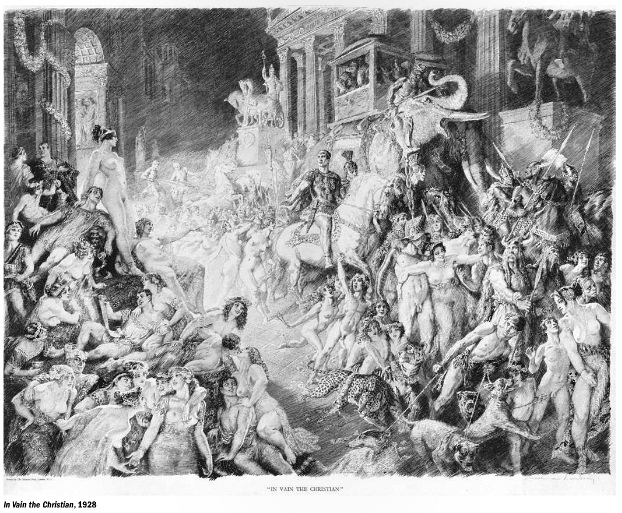
Norman Lindsay, In Vain the Christian, 1928
There is no known exact record of the lost works, or even just the actual number. Jane Glad refers to hundreds but then later states, “A hundred would be a conservative guess, not counting the many etching prints.” (123 etchings according to Lin Bloomfield in The Complete Etchings of Norman Lindsay, page 169).
Lin Bloomfield, in her Editor’s Epilogue in Model Life (Odana Editions), mentions “almost a thousand” (perhaps including lithographs, etc.?).
The 100 estimate appears likely because Rose describes the writer and their close friend Noel Langley spending a morning going through all of the crates and pictures when she visited his home in California before they were shipped, something you couldn’t realistically do with much more than a 100 originals.
It would also coincide with the number taken by Rose (and Norman) on their previous trip to the U.S. comprised of about “60 pen and inks, 40 watercolours…” as reported in the Daily Telegraph (July 24, 1931, p.7).
In a letter to his son Philip at that time, Norman estimated the worth of the lost works to be 17,000 Australian pounds, about $560,000 in today’s money! That figure reflects the change in currency without updating the values!
Norman took the loss in stride, even going back to his preliminary pencil sketches and repainting some of the watercolours (two examples can be found in the Odana Watercolour book, Merchandise and Bacchanal.)
Rose did not. It haunted her the rest of her life. She considered it “the major tragedy of my life.”
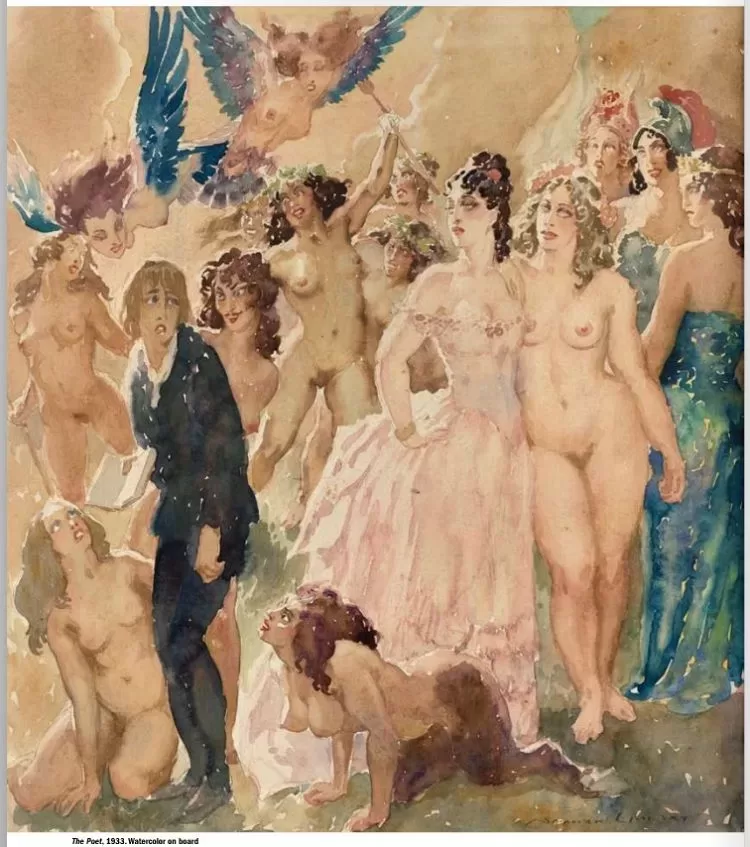

The Poet, 1933, Norman Lindsay, watercolour on board
Being an extremely prolific artist, Norman never ran out of art for Rose to sell.
One of the major outlets of his work here was Ben Abramson’s Argus Bookshop in Chicago, Illinois. In The Argus Book Shop: A Memoir by his daughter Deborah Covington, she relates how “one of the most exciting events at the Argus” was an exhibition of Lindsay’s works.
She mentions how Ben admired Norman’s work and sold a great deal of it. She also supplies us with a wonderful childhood anecdote of how when she had been home sick for a week her mother invited her class to visit her.
During their visit the kids swarmed into her family’s living room and consumed hot chocolate and cookies. When she had recuperated and returned to school one of the boys refused to play with her saying his mom had forbidden it because the Abramson house had “naked women in it.”
Ben led his distressed daughter into the family living room and figured out that the boy was referring to a small painting by Lindsay of a female nude hanging on the wall.


Untitled, Norman Lindsay, 1933, watercolour on board
It was during the 1940s that a remarkable collection of art was being put together by the Boston attorney John Merriam, and the Argus Book Shop plays a prominent role.
John Merriam, in his personal notebook dated August 11, 1982, cites in reference to his acquisition of eight John Austen originals:
“I acquired all of these from the Argus Book Shop, Ben Abramson proprietor, during the early 1940s when passing through Chicago on military duty.”
Boston attorney John Merriam
It is from this source, and various others such as Fabes, and Ray Lewis, that John Merriam put together a significant collection of art including the originals by Lindsay, and many originals by Flint, Bayros, Kley, and others.
The writer of this article was fortunate in viewing this collection more than once, and of the twelve originals by Lindsay that held me spellbound in the John Merriam three-story brownstone at 20 Embankment Road, six illustrate this article.
Of the six, certainly two gems that stand out are the watercolour Beauties and the Beasts, dated 1933 and measuring 18.5 by 16 inches, and the wash drawing Urs Graf in Heaven, signed and titled, measuring 20.5 by 30.5 inches.
Another noteworthy watercolour from the Merriam collection is March of the Scalliwags, dated 1947, which begs comparison to the oil painting entitled March of the Scalliwags which can be found in Norman Lindsay Oil Paintings, pp. 238-239.
The watercolour is closer to the oil in the photograph of the artist seated in front of the painting than the full-page painting opposite it.
It differs in a few important respects, with the trumpet playing dwarf on the right side replaced by a goat with two children behind it, with a flute playing Norman self-caricature standing behind them, and the additional girl front left, next to Miss Buttocks in lieu of the wine jug.
Most artists use a favourite composition more than once — to cite just one major example, Arnold Bocklin painting his influential Isle of the Dead at least four times.
Lindsay was no exception, producing for example both etching and watercolour treatments of Unknown Seas, and identical watercolour and oil versions of Captured.
But, with March of the Scallywags were two different oils executed, or did Lindsay paint over one? (Also not unheard of with oil painters.)
Lindsay’s wonderful sense of humour was not only evident in the previously discussed cartoons he did for journals like the Sydney Bulletin, but it was also a major reason for the success of his novels.
When The Cousin from Fiji appeared here, published by Random House in 1945, it was reviewed by the critic Bennett Cerf, known to many Americans as a TV personality on such shows as What’s My Line?, who wrote:
“How accurate a picture this is of high life in Australia I am not prepared to state. I only know that I laughed myself sick over it.”
critic Bennett Cerf
In the early 1950s another American, on a far more limited budget, was attempting to collect Lindsay material.
Roy Krenkel, a rising star in the field of comics and paperback covers at the time, became enamoured with Norman’s art.
Krenkel made contact with Lindsay’s agent at the time, Sedon-Thompson, and engaged in a spirited exchange of letters, not just going over the details of purchasing more than a few etchings, and begging and pleading for snapshots of watercolours, but also sharing opinions and even comparing interpretations of the symbolism of various works.
In fact Krenkel refers to their epistolary exchanges as an indulgence “in this sport of symbolic detective work. We have not seen any record of what Lindsay may have had to say about the “message” of To The Refined in Spirit, but Roy Krenkel took a stab at it reflecting in a letter to Sedon Thompson dated September 23, 1952:
“I associate goats with fertility and with rites of black magic—but as a clue it isn’t enough. The only ‘focal’ figure in the whole thing—the only one whose attitude or action seems to dominate is, of course, the magnificent tousled amazon with the fierce eyes and clenched hand.”
Lindsay did in fact explain some works, for example, in letters to the owners of the watercolours Unknown Seas and Out of the Dawn, more often than not, drawing from “Greek conception(s).”
Roy Krenkel
Enter the Magicians, a very important etching for several reasons; he considered it technically his finest, again, it was the first artwork sold at the exhibition at the NY Roerich museum, and the Krenkel collection includes it (parties seriously interested in this unique collection should contact the author of this article), Lindsay gave the following explanation of its symbolism:
“The Magicians of course, are the artists — the creators, whose function is to create human consciousness by revealing life in all its complexities of human passion to mankind.
The figure of Life is still veiled, but the veil is transparent — already art has made its revelation and Life, since Homer made its first analysis, is revealed to us.
We know the passions which motivate man, but Life will always be an enigma, and therefore the transparent veil remains.
The dignified figure of the Magician represents Creative Art — the malicious small magician represents the destructive element in Art…
The whirling image of the five pointed star represents Fire, the dripping figures emerging from below represent Water, the Salamander and the Naiad — the elemental symbols of the creation of biological life.
The strong figure clasping the boy and girl represent the bi-sexual construction of the human entity—half man, half woman … the Bull with the primitive male figure symbolizing the fecundity of life. …
It is against my principle to explain my works. Firstly, the explanation destroys the intellectual exercise of divining the picture’s motive, and secondly, it does not matter what intellectual concept the picture arouses as long as it is emotionally and aesthetically responded to.”
Norman Lindsay
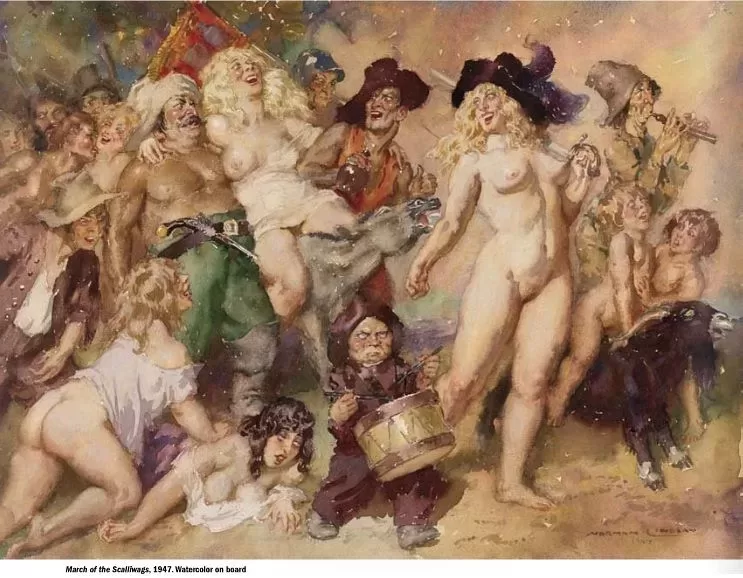

March of the Scalliwags, 1947, Norman Lindsay, watercolor on board
Sedon-Thompson himself, was quite passionate about Lindsay’s art, as reflected in one letter from 1951 describing at some length, among other pieces for sale, the watercolour Girls and Glory, from “the jubilant collection of very assorted females” to the “about 200 stars that even seem to twinkle”, this, despite the fact that it had already just sold for 300 gns (it changed hands again in 2001 for $30,000AUS at auction.)
During this time, Krenkel corresponded under the name of his friend and fellow comic book artist Al Williamson.
Apparently Lindsay, having seen some of the artwork of Virgil Finlay, renowned for his illustrations in the pulps, resenting what he felt were some direct “swipes” or “lifting” things like demons from his art, confused Krenkel with Finlay.
Consequently, when Krenkel admitted to the use of Williamson’s name, Sedon-Thompson broke things off, apologizing to Krenkel but asserting he did not care to risk Norman’s and Rose’s displeasure.
Krenkel did in fact execute a group of drawings in NL’s style, but as an admitted homage and not for publication.
It is obvious that Krenkel idolized Lindsay’s work from statements like the one he made to Sedon-Thompson in a letter postmarked September 16, 1952,
“The absolute ease and surety — the terrific vitality of Lindsay’s creations never cease to amaze me
There is something about Lindsay’s work, at its best that is, that sets it apart and, in my opinion, above all other pictorial work. I think it is his feeling for great, unifying rhythms—every line, every mass relates fluidly to every other.”
Roy Krenkel
There has been at least one other major collection of Lindsay’s art here. At a Sotheby’s auction in Sydney Australia on August 27 and 28, 2001, at least a half dozen fine watercolours and one wash drawing were sold.
The provenance cited was Yale Bradlyn of Florida who apparently acquired them in the 1950s from Sedon Galleries.
Also notable is Managing Director of Sotheby’s at the time, Martin Gallon, in his catalogue introduction, refers to the “Norman Lindsays from Florida” as one of the two high spots of the sale, a rare nod of respect given to this out of the mainstream artist.
It is also worth noting that one of the watercolours Girls and Glory that had been described (as noted above) by Sedon Thompson to Roy Krenkel was one of the lots. Girls and Glory was destined to end up in Yankee hands!
Later that decade (the 50s) in Chicago, Illinois, arguably the epicentre of Lindsayana in America, The American Book Collector published no less than three articles of great interest to Lindsay collectors.
The first was a three-part (monthly) article running from September to November 1956, entitled “Collecting Norman Lindsay” by George Mackaness, wherein he speaks from personal experience, having successfully collected all but a couple of the titles under discussion.
The other articles were “The Fanfrolico Press, an appreciation” by Anthony Adams, in the April 1959 issue, and again George Mackaness with “Australian Private Presses” in the February 1960 issue. All of these articles were illustrated with repros of dust jackets or title pages from various Lindsay titles.
In 1955 Lindsay sold the film rights to The Cautious Amorist to fellow writer and family friend Noel Langley, who co-produced it, wrote the screenplay, directed it, and released it here in America as Adventures of Sadie starring Joan Collins.
Unfortunately, according to Langley in a letter to Lindsay, between movie censors disallowing “charming costumes” and Joan Collins’ contract forbidding any nude shots, Langley was hamstringed and ended up with a movie he considered a “Bowdlerised, deodorized version (that) was so clean and tidy that it almost defeated its own purpose.”
However, Langley claimed that it found a very receptive American audience as a 20th Century Fox second feature playing “to roars of continuous laughter all over the country.”
Despite loving pirates as a literary and artistic inspiration, Lindsay was quite agitated by the reality of his work being pirated here (used without his permission with no royalties going to him.)
He complained bitterly over publications such as the Three Sirens Press edition of Lysistrata (NY, 1932) and Inns of Greece and Rome (Covici, 1928), not only for “ignoring the copyright conventions of other nations” but for the horrible reproduction quality.
This also occurred in magazines like Adam and Eros and notably in Playboy (published in Chicago, IL), in an article titled “Art Nouveau Erotica” in the December 1967 issue, where six of Lindsay’s works appear along with artists such as von Bayros.
Two observations can be made regarding the piracy of his work, not to condone it, but to put it in perspective. The piracy here in the U.S. certainly served to spread his fame a little farther and wider, and U.S. publishers were not the only guilty parties, his work was pirated back in Australia as well.
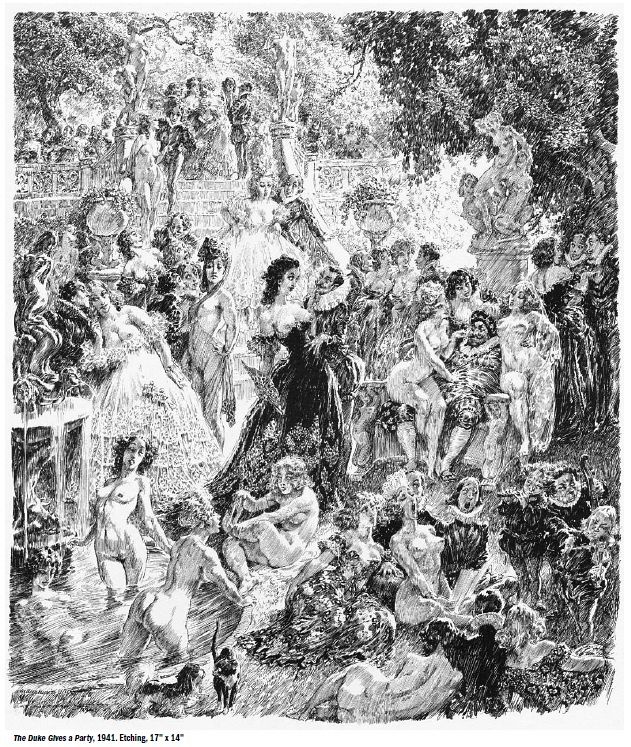

The Duke gives a Party, 1941, Norman Lindsay, etching
It is in this same context, that of spreading his fame, that although technically outside the scope of this article, mention should be made of Michael Powell’s cinematic treatment of Norman’s novel, preserving the title Age of Consent, and little else, starring James Mason and Helen Mirren, in 1968; and in 1994 John Duigan directed Sirens, starring Sam Neill as Norman Lindsay, a flawed film but yet of some interest.
Finally, a film that has not really been distributed here in America, the animation film very loosely based on Lindsay’s Australian children’s classic, The Magic Pudding, starring the voices of Sam Neill, John Cleese, and Geoffrey Rush.
The DVD is notable for the added bonus “Making Of” segment, during which we get to see Lindsay himself, for just a precious moment, being interviewed on Australian television, commenting on why he wrote The Magic Pudding.
This is the book that has earned Lindsay praise in children’s book circles around the world, about which Robert Holden, a renowned authority on book illustrators and children’s books as well as a novelist, in his A Golden Age, Visions of Fantasy, Australia’s Fantasy Illustrators (Angus and Robertson, 1992), states, “In its own day it was virtually without parallel, today its appeal seems timeless and its classic status unchallenged.”
Recognition for Lindsay’s work here in America has begun to surface with increasing frequency over the last couple of decades.
In 1993, SooLoo Press, feeling that the American Lindsay fan had been underserved, published a boxed collection of 30 previously unpublished watercolours entitled Mermaids and Moonlight.
The same year, Leslie Cabarga, in his Dynamic Black and White Illustration, One Hundred Years of Line Art, 1900-2000, featured two decorations and two full-page pen and inks from Lindsay’s Lysistrata.
To coincide with Lin Bloomfield’s release of the definitive volume on Lindsay’s etchings, Norman Lindsay Etchings, Catalogue Raisonné, The Old Print Shop in New York City held an exhibition and sale of 40 original etchings that ran from November 2 until Christmas 1999.
To add an additional enticement, there was a free lecture by an Australian expert on both etchings and Lindsay’s work in this medium, Josef Lebovic (himself the owner of a fine gallery.)
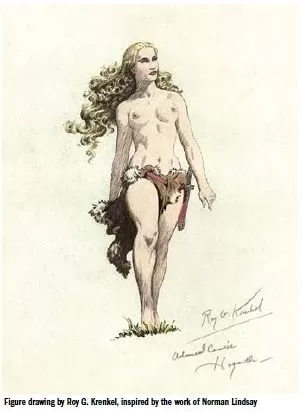

Figure drawing, Roy G Krenkel, inspired by Norman Lindsay
Perhaps it is not too much of a stretch to assert that Norman Lindsay has had more of an effect on American artists than those back in Australia, or any other country.
More recently than the aforementioned Flanagan, Finlay, and Roy Krenkel (and others of their generations), his influence seems to be gaining strength here over the years.
For example, Roy Krenkel’s friend and fellow artist Al Williamson reminisced in Hidden Lands (Dark Horse Books, by Yeates, Schultz, Ringgenberg, October 2004), “Roy (Krenkel) was the guy who turned me on to all the great artists, like Norman Lindsay.”
In Bettie Page Rules (Dark Horse, September 2007), we find artist Jim Silke depicting Lindsay’s Lysistrata, the illustration where she is standing in front of the male citizens, with Lysistrata sporting Bettie’s face.
Other American artists too numerous to name, from William Stout to Gary Gianni, cite Lindsay as, if not a stylistic influence, a major inspiration.
Norman himself would frown down from Olympus if this article failed to acknowledge the two foremost champions of his work over the last 30 years, appropriately enough, both women.
First, Helen Glad, his granddaughter, who has been involved in virtually every aspect of promoting his work from acting on the board at the Norman Lindsay Springwood Museum and National Trust to writing catalogue entries (who could possibly write more authoritatively or insightfully?) for major auction houses, and everything in between.
Then there is Lin Bloomfield, starting with editing the splendid volume The World of Norman Lindsay (1979), and over the last ten years establishing Odana Editions, being ably assisted by both Jane and Becky Bloomfield.
Their wonderful books have now covered almost every aspect of Lindsay’s output and are distributed here in the U.S. by Bud Plant. Future titles, and further affordable facsimile etchings, are eagerly anticipated!
In his serious, and what he considered to be his most important work, Norman Lindsay consistently expressed his innermost convictions, adhering to the belief that the most crucial thing in the world was Creative Effort, and that its eternal principle of life, life being the prime enigma of the universe, and it’s image, being the symbol of beauty, is the feminine dominant.
Or, as he wrote quite succinctly in his book Scribblings of an Idle Mind, “ … the function of the Nude in Art … (is) of the first importance … Its symbol remains to us as a freed mind in a freed body,” and “The naked human body is life’s supreme symbol.”
It is his faithfulness to this philosophy, and his intimate sharing of his emotions springing from it, as expressed in the compositions that sprung from his imagination inspired by it, that recall the words of H. DeVere Stacpoole, author of The Blue Lagoon, in his introduction to The Poems of Francois Villon (NY, John Lane, 1914), one of Norman’s very favourite poets, that could be applied to Lindsay with equal validity:
“in any civilization to follow ours he will hold the same high place; for it is his essential that the forms of his genius are the concretions of eternal principles, not the flowery expansions of ephemeral moods.”
H. DeVere Stacpoole
— © Louis Irmo, 2009 originally published in Illustration magazine issue number 27, Summer edition 2009 and has been republished with permission.
This article is dedicated to Ian Kelf, great guy, the ultimate Lindsay collector, and wonderful friend.
ACKNOWLEDGEMENTS
Helen Glad and the Lindsay Estate. Photographs (Merriam Collection) courtesy of the Print Department of the Boston Public Library. Robert Holden, and his invaluable research. Wm. Hallam Webber for his generous sharing and assistance. Finally, I must thank Karen Shafts, Jane Bloomfield, Tom Mathieson, Barry Klugerman, Randy Broecker, John Dowling, and my wife Susan, my muse and collaborator.
SOURCES
- My Mask, Norman Lindsay, Angus and Robertson, 1970
- The Scribblings of an Idle Mind, Norman Lindsay, Lansdowne Press, 1966
- Model Life, Rose Lindsay, Lin Bloomfield, Odana, 2001
- Portrait of Pa, Jane Lindsay, Odana, 2007
- The World of Norman Lindsay, ed. Lin Bloomfield, MacMillan, 1979
- The Letters of Norman Lindsay, ed. Howarth and Barker, Angus and Robertson, 1979
- The Embattled Olympian, John Hetherington, Oxford University Press, 1973
- The Complete Etchings of Norman Lindsay, ed. Lin Bloomfield, Odana Eds, 1998
- Norman Lindsay Oil Paintings 1889-1969, ed. Lin Bloomfield, Odana Editions, 2008
- The letters of Roy Krenkel—Sedon Thompson (Wm. Hallam Webber collection)

